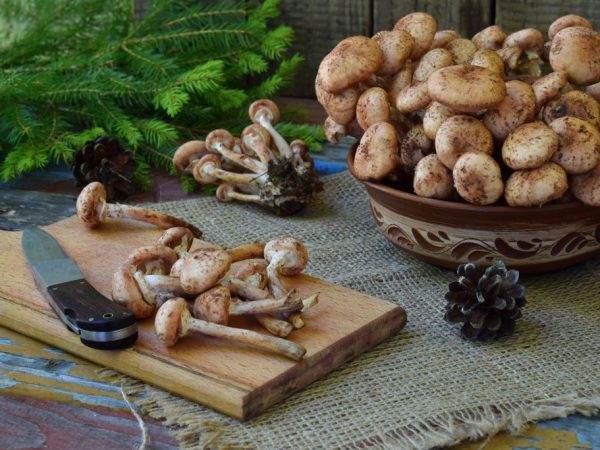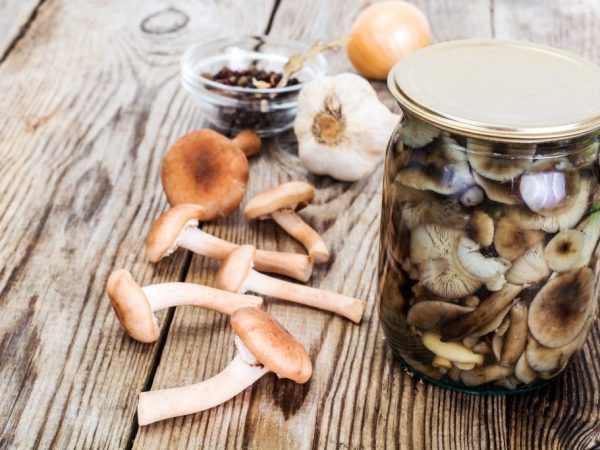Methods and terms of storage of honey agarics
Conditionally edible mushrooms are widely used in the cooking of our vast Motherland. They are frozen, fried, salted and pickled. Each cooking method has its own period during which honey agaric storage is permissible.

Methods and terms of storage of honey agarics
How to keep fresh mushrooms
It is permissible to store cut fresh mushrooms after harvesting in the forest until further culinary processing for no more than 6 hours. A suitable place where you can store fresh mushrooms is a refrigerating chamber or a basement.
It is best to peel and cook cut mushrooms immediately after harvest. The less fruit bodies lie untreated, the better. Otherwise, the collected lamellar mushrooms easily absorb moisture from the environment (due to their hygroscopicity) and foreign odors, mold and lose their elasticity.
How to store frozen mushrooms
Freezing fresh mushrooms is the easiest way to preserve them.
Before freezing, they are sorted out, removing debris, the lower edge of the mushroom leg is cut off, and the white shell is removed from large specimens. It is recommended to store mushrooms without preliminary washing: otherwise, during the freezing process, they will stick together. If pre-washing or soaking is required, dry them thoroughly before placing them in the freezer.
For freezing, mushrooms are placed in portions in plastic bags, if there is free space in the freezer, in food containers.
It is permissible to freeze mushrooms fresh, pre-boiled or fried. At the same time, during the heat treatment, they try not to add salt.
Terms and conditions of storage
Store mushrooms frozen fresh is required at a temperature of -18 ... -24 ° C. By supplying such conditions without additional defrosting and subsequent secondary freezing, mushrooms can survive for 3 to 6 months, without losing their beneficial and taste qualities, being suitable for consumption for food purposes.
Honey mushrooms frozen after preliminary heat treatment are able to maintain their gastronomic characteristics throughout the year.
How to keep pickled mushrooms
Honey mushrooms are pickled in glass jars, rolling them up or simply closing them with nylon lids. An acceptable option is using a marinade or pre-frying in oil. Pickled mushrooms with a bite have the longest food shelf life with good appearance retention.
Before marinating, the mushrooms are soaked in water for about an hour.
Terms and conditions of storage
It is always important to remember that the timing, i.e. the storage duration of pickled mushrooms is 100% dependent on the correct preliminary preparation of the mushrooms.
Irina Selyutina (Biologist):
A little about pickling honey agarics:
- The shelf life of pickled mushrooms increases significantly if the jars used for these purposes are pre-sterilized together with the lids, and then the blank is sterilized in the jar.
- If you are doing express marinating for use soon, then sterilizing the jars is not necessary. You can store such a blank for no more than 2 weeks in the refrigerator.
- You can pickle honey mushrooms not only in glass, but also in ceramic, or other dishes that do not lend themselves to oxidation.
- When pickling honey agarics (and other mushrooms too), acetic acid is poured into the marinade just before the end of the cooking process in order to maintain its maximum concentration.
- To prevent the marinade from reacting with the metal lid of the jar, 2-3 tbsp is poured into each. tablespoons of hot vegetable oil. Such a product is stored for up to 12 months, and the sample can be removed somewhere in 25-30 days.
In rolled up jars, subject to all preservation conditions, the shelf life of mushrooms pickled with vinegar is 1 year. Marinated blanks in a jar, tightly closed with a polyethylene lid, remain valid for no more than 6 months. The shelf life of pre-fried mushrooms filled with vegetable oil is also 6 months, regardless of the type of packaging. This period assumes that the products are stored in a refrigerator at a temperature not exceeding + 5 ° C.

Pickled mushrooms are stored for no more than a year
It is also permissible to store pickled mushrooms at room temperature. In this case, the shelf life is reduced to 3-4 months, regardless of the type of seaming. Room storage does not apply to mushrooms pickled in oil.
How to keep salted mushrooms
Mushrooms can be saved by pre-salting them. Salt honey agariches possibly hot or cold.
Terms and conditions of storage
The shelf life of mushrooms salted in different ways is different:
- hot salting method: mushrooms can be stored in a refrigerator at a temperature not higher than + 5 ° C for 8-12 months;
- cold salting method: The shelf life of the mushrooms harvested in this way is no more than six months and requires regular checks during storage for the absence of mold and topping up the brine to a level that completely covers the mushroom mass.
Suitable conditions are temperature + 5… + 8 ° С. When the temperature drops to 0 ° C, salted blanks freeze and lose their gastronomic qualities, and when the temperature rises to 10 ° C and above, they become sour, moldy and become unusable.
How to save dried mushrooms
Drying mushrooms is another way to preserve them. In terms of taste, they are not inferior to freshly prepared ones, and in terms of nutritional value, they are even better than pickled ones. The only drawback of dried mushroom blanks is the loss of an attractive appearance.
Terms and conditions of storage
Vacuum food containers and glass containers, tightly closed with a lid, are suitable for storing dried mushrooms. It is permissible to store them in fabric bags, however, it should be ensured that there is no dampness and foreign odors in the storage area.
Dried mushroom stocks are checked every 30 days for the presence of pests - bugs. If signs of the presence of insects are detected, the mushrooms are rinsed under running water and heated in an oven at a temperature of + 70 ° C.
The shelf life of dried honey agaric is 1 year, provided proper conditions are provided.
Conclusion
There are different ways to keep honey mushrooms. Each of them is characterized by its own terms, during which the blanks remain suitable for use, it is not recommended to exceed them. These terms can be reduced if the conditions in which the mushrooms are stored are violated.



